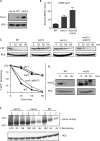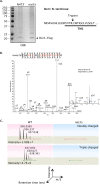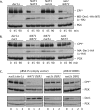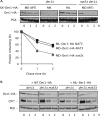N-terminal acetylation of the yeast Derlin Der1 is essential for Hrd1 ubiquitin-ligase activity toward luminal ER substrates
- PMID: 23363603
- PMCID: PMC3608499
- DOI: 10.1091/mbc.E12-11-0838
N-terminal acetylation of the yeast Derlin Der1 is essential for Hrd1 ubiquitin-ligase activity toward luminal ER substrates
Abstract
Two conserved ubiquitin ligases, Hrd1 and Doa10, mediate most endoplasmic reticulum-associated protein degradation (ERAD) in yeast. Degradation signals (degrons) recognized by these ubiquitin ligases remain poorly characterized. Doa10 recognizes the Deg1 degron from the MATα2 transcription factor. We previously found that deletion of the gene (NAT3) encoding the catalytic subunit of the NatB N-terminal acetyltransferase weakly stabilized a Deg1-fusion protein. By contrast, a recent analysis of several MATα2 derivatives suggested that N-terminal acetylation of these proteins by NatB was crucial for recognition by Doa10. We now analyze endogenous MATα2 degradation in cells lacking NatB and observe minimal perturbation relative to wild-type cells. However, NatB mutation strongly impairs degradation of ER-luminal Hrd1 substrates. This unexpected defect derives from a failure of Der1, a Hrd1 complex subunit, to be N-terminally acetylated in NatB mutant yeast. We retargeted Der1 to another acetyltransferase to show that it is the only ERAD factor requiring N-terminal acetylation. Preventing Der1 acetylation stimulates its proteolysis via the Hrd1 pathway, at least partially accounting for the ERAD defect observed in the absence of NatB. These results reveal an important role for N-terminal acetylation in controlling Hrd1 ligase activity toward a specific class of ERAD substrates.
Figures







Similar articles
-
A Conserved C-terminal Element in the Yeast Doa10 and Human MARCH6 Ubiquitin Ligases Required for Selective Substrate Degradation.J Biol Chem. 2016 Jun 3;291(23):12105-18. doi: 10.1074/jbc.M116.726877. Epub 2016 Apr 11. J Biol Chem. 2016. PMID: 27068744 Free PMC article.
-
The yeast ERAD-C ubiquitin ligase Doa10 recognizes an intramembrane degron.J Cell Biol. 2015 Apr 27;209(2):261-73. doi: 10.1083/jcb.201408088. J Cell Biol. 2015. PMID: 25918226 Free PMC article.
-
A conserved ubiquitin ligase of the nuclear envelope/endoplasmic reticulum that functions in both ER-associated and Matalpha2 repressor degradation.Genes Dev. 2001 Oct 15;15(20):2660-74. doi: 10.1101/gad.933301. Genes Dev. 2001. PMID: 11641273 Free PMC article.
-
[Physiological Roles of Ubiquitin Ligases Related to the Endoplasmic Reticulum].Yakugaku Zasshi. 2016;136(6):805-9. doi: 10.1248/yakushi.15-00292-2. Yakugaku Zasshi. 2016. PMID: 27252059 Review. Japanese.
-
Endoplasmic reticulum-associated degradation and beyond: The multitasking roles for HRD1 in immune regulation and autoimmunity.J Autoimmun. 2020 May;109:102423. doi: 10.1016/j.jaut.2020.102423. Epub 2020 Feb 11. J Autoimmun. 2020. PMID: 32057541 Free PMC article. Review.
Cited by
-
The biological functions of Naa10 - From amino-terminal acetylation to human disease.Gene. 2015 Aug 10;567(2):103-31. doi: 10.1016/j.gene.2015.04.085. Epub 2015 May 16. Gene. 2015. PMID: 25987439 Free PMC article. Review.
-
N-terminal methionine excision of proteins creates tertiary destabilizing N-degrons of the Arg/N-end rule pathway.J Biol Chem. 2019 Mar 22;294(12):4464-4476. doi: 10.1074/jbc.RA118.006913. Epub 2019 Jan 23. J Biol Chem. 2019. PMID: 30674553 Free PMC article.
-
Sumoylation, Phosphorylation, and Acetylation Fine-Tune the Turnover of Plant Immunity Components Mediated by Ubiquitination.Front Plant Sci. 2017 Oct 10;8:1682. doi: 10.3389/fpls.2017.01682. eCollection 2017. Front Plant Sci. 2017. PMID: 29067028 Free PMC article. Review.
-
Ubiquitin-dependent protein degradation at the endoplasmic reticulum and nuclear envelope.Semin Cell Dev Biol. 2019 Sep;93:111-124. doi: 10.1016/j.semcdb.2018.09.013. Epub 2018 Oct 9. Semin Cell Dev Biol. 2019. PMID: 30278225 Free PMC article. Review.
-
Protein quality control at the inner nuclear membrane.Nature. 2014 Dec 18;516(7531):410-3. doi: 10.1038/nature14096. Nature. 2014. PMID: 25519137 Free PMC article.
References
-
- Bays NW, Gardner RG, Seelig LP, Joazeiro CA, Hampton RY. Hrd1p/Der3p is a membrane-anchored ubiquitin ligase required for ER- associated degradation. Nat Cell Biol. 2001;3:24–29. - PubMed
-
- Biederer T, Volkwein C, Sommer T. Role of Cue1p in ubiquitination and degradation at the ER surface. Science. 1997;278:1806–1809. - PubMed
-
- Carvalho P, Goder V, Rapoport TA. Distinct ubiquitin-ligase complexes define convergent pathways for the degradation of ER proteins. Cell. 2006;126:361–373. - PubMed
-
- Chen P, Johnson P, Sommer T, Jentsch S, Hochstrasser M. Multiple ubiquitin-conjugating enzymes participate in the in vivo degradation of the yeast MATα2 repressor. Cell. 1993;74:357–369. - PubMed
Publication types
MeSH terms
Substances
Grants and funding
LinkOut - more resources
Full Text Sources
Other Literature Sources
Molecular Biology Databases

